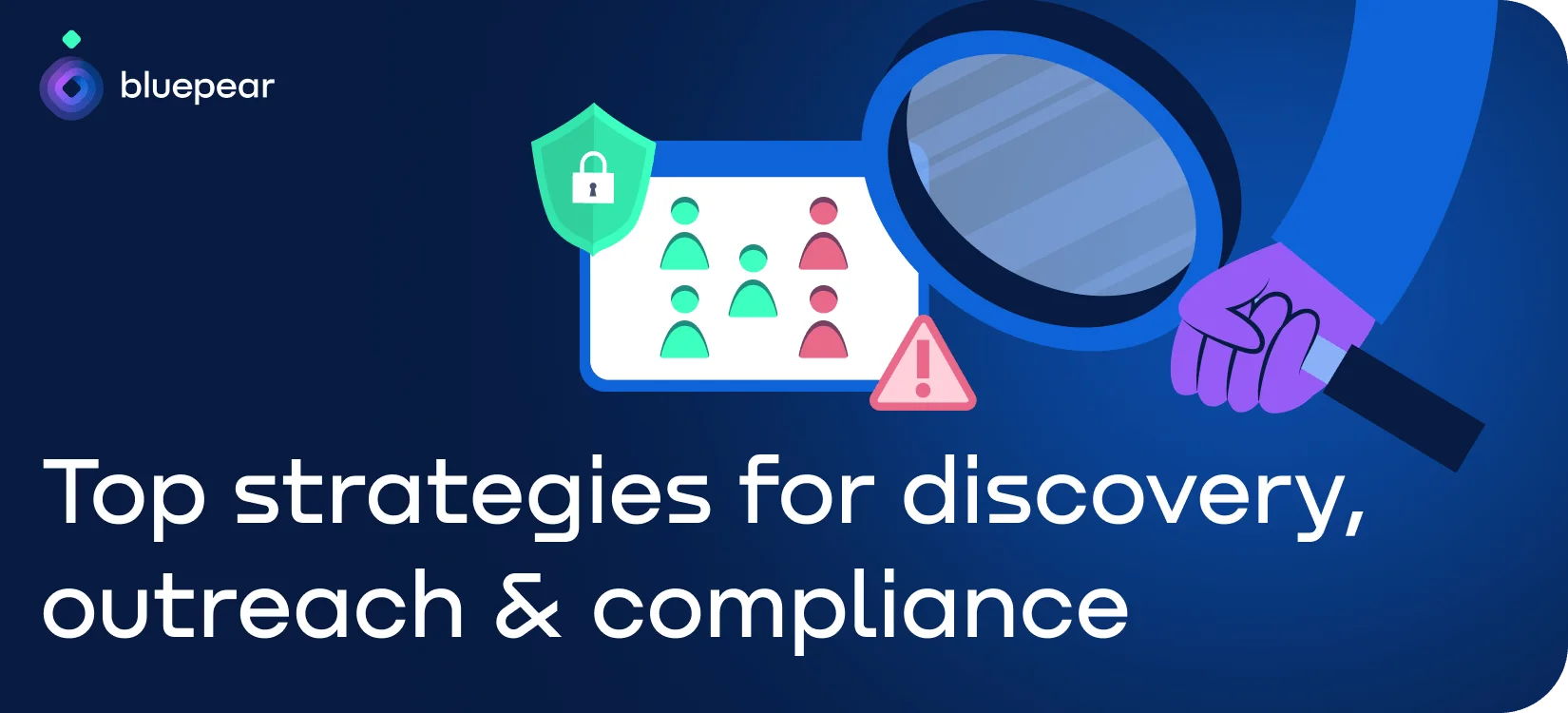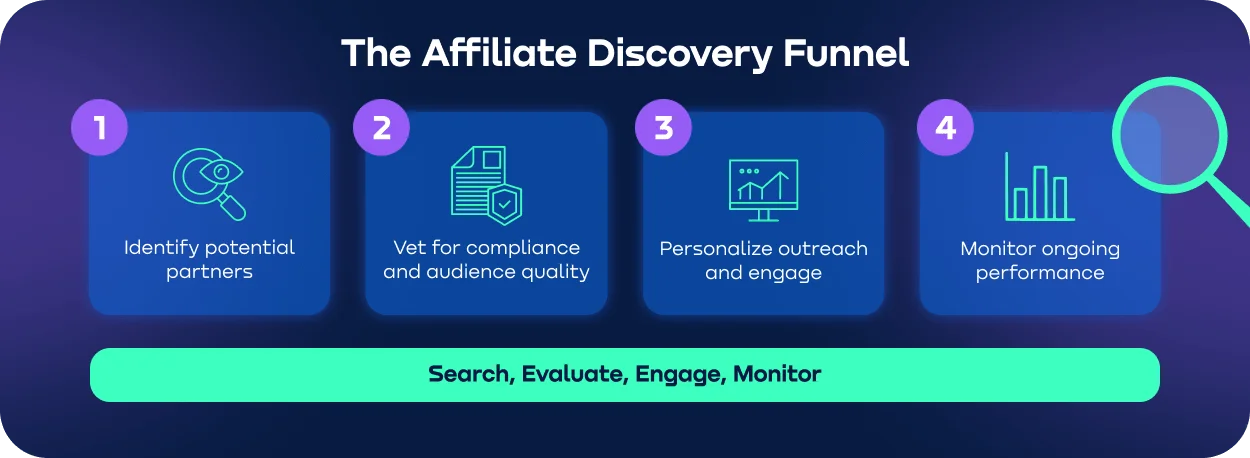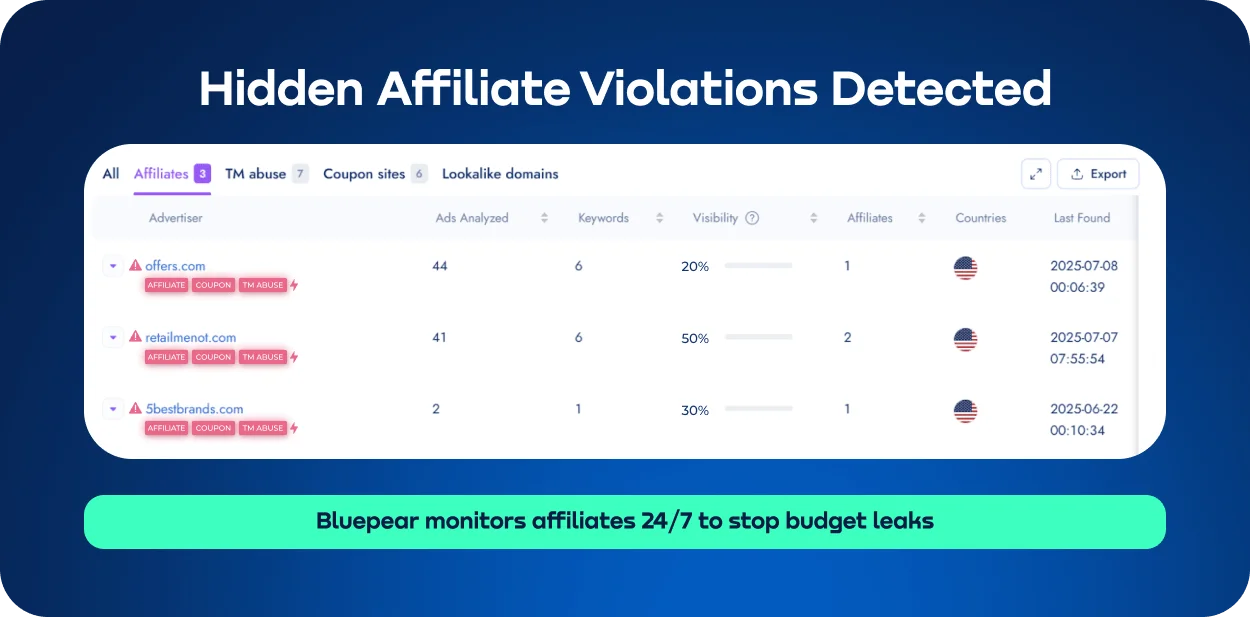
Contents
In 2025, affiliate recruitment has become a critical success factor for every performance-driven brand. As competition intensifies and acquisition costs rise across channels, the ability to identify and engage high-quality affiliate partners is a core growth function.
According to the Affiliate Marketing Benchmark Report 2025 by Awin and Digiday, over 63% of advertisers cite “finding new quality affiliates” as their top challenge in scaling programs. At the same time, more than 40% of affiliate traffic across major verticals is now coming from previously untapped sources like micro-influencers, niche SEO sites, and closed communities.
In a crowded landscape filled with both opportunity and risk, brands face a dual challenge: finding new affiliates who deliver value, and protecting themselves from fraudsters who misrepresent traffic or even hijack your brand. Whether you're launching a new program or scaling an existing one, it's crucial to have a strategy that strikes a balance between growth and control. In this article, you will find an answer to the question “How to find affiliates?” It outlines the top strategies for finding, attracting, and onboarding new affiliates while minimizing exposure to fraud, wasted budget, and compliance issues.
Why New Affiliate Discovery Is Critical for Scaling Your Program
Scaling an affiliate program isn’t just about increasing headcount or raising CPA caps. At its core, sustainable growth depends on finding new affiliates. They are partners who can drive qualified traffic, respect your compliance rules, and deliver long-term value. It’s essential to define what a “high-quality affiliate” actually looks like for your brand. Without a clear definition, it becomes easy to onboard partners with unproductive affiliate outreach who deliver short-term volume but fail to drive meaningful business results.
The biggest challenge during finding new affiliates is an overload of the wrong ones. As programs expand, they’re often flooded with applications from low-quality publishers, coupon abusers, or outright fraudsters. Many promise volume but deliver recycled or incentivized traffic that does little more than inflate short-term KPIs. In worse cases, they can actively damage your brand, violate GEO restrictions, or trigger bonus abuse patterns that attract regulatory attention.
Without a structured discovery and vetting process, you’re exposing your program to real operational and legal risk. Affiliate scams have become more sophisticated in 2025, from cloaking and brand bidding to lead injection and fake FTDs. And without ongoing monitoring, these tactics often go undetected until significant damage has been done.
Smart affiliate discovery is about finding new, better affiliates. The goal is to identify publishers who align with your vertical, geo focus, traffic rules, and performance expectations and to engage them before your competitors do. That requires a proactive outreach mindset, supported by the right tools, data sources, and compliance infrastructure.
Common Mistakes in Affiliate Discovery and Outreach
One of the most common mistakes in finding new affiliates is blindly listing your program on affiliate networks or marketplaces, assuming that visibility alone will attract quality partners. While networks can be a useful source of discovery, they also attract a large volume of opportunistic publishers, many of whom use questionable traffic sources or promote dozens of competing brands with little loyalty. Without proper filtering, you risk onboarding affiliates who damage more than they contribute.
Another frequent error is skipping due diligence. Accepting affiliates without verifying their traffic sources, audience quality, or business model opens the door to compliance issues and fraudulent activity. In 2025, where affiliate scams are more sophisticated than ever, neglecting even basic checks — like reviewing a site’s content, validating traffic methods, or requesting performance data — is a costly oversight.
Poor outreach execution is also a widespread issue. Sending mass, non-personalized messages to hundreds of affiliates rarely generates meaningful responses. Top-tier partners expect brands to understand their business, speak their language, and offer relevant value.
These mistakes share a common root: the absence of a structured, thoughtful discovery process. Successful affiliate programs don’t rely on luck or volume. They combine targeted outreach, clear qualification criteria, and reliable monitoring tools to ensure that every new partner is aligned, compliant, and performance-ready.
Top Strategies to Find New Affiliates
Below are proven strategies that leading iGaming programs use to consistently find new affiliates.
1. Segment Your Prospects by Niche and Traffic Type
Not all affiliates are the same, and treating them as such is a fast track to irrelevance. When you discover new affiliates, segment them by niche and by traffic type (organic, paid, social, email). This allows you to tailor your message, offer structure, and onboarding process to their actual business model, instantly increasing relevance and response rate.
2. Use Data to Prioritize High-Potential Partners
Instead of cold-guessing who to contact, leverage real metrics. Tools like Bluepear can help you identify websites driving high traffic, uncover competitors’ affiliates, and detect paid search violations. Focus on partners with proven reach, clean reputations, and historical performance in your vertical.
3. Craft Clear, Personalized Outreach Messages
A great outreach message is short, specific, and relevant. Avoid long intros. Explain why you’re reaching out, and give them a reason to care. Here’s a simple cold outreach example:
- Subject: Potential Collaboration with [Your Brand]
- Hi [First Name],
- I’ve been following your content on [platform/website] and noticed your strong focus on [niche, e.g. crypto casinos]. We’re currently expanding our affiliate program at [Brand] and looking to partner with high-quality publishers like you.
- I’d love to share a few key details about the offer: [details]. Would it make sense to connect for a quick call or chat this week?
- Best,
- [Your Name]
Personalization shows respect and dramatically increases your chance of landing a reply.
4. Balance Warm and Cold Outreach
Warm outreach (e.g., through mutual connections, Telegram groups, or LinkedIn interactions) tends to convert better. But cold outreach still works, if it’s backed by research. Ideally, when you discover new affiliates, build hybrid campaigns: start warm where possible, and use cold emails to scale.
5. Follow Up and Nurture Relationships Over Time
Most quality affiliates won’t respond after one email. A thoughtful follow-up strategy (2–4 polite messages over 10–14 days) shows professionalism and persistence in finding affiliate marketers and partners. Once contact is made, share performance data, provide support, and keep the conversation alive.

How to Find New Affiliates Like a Pro
The first step is to evaluate whether an affiliate’s audience matches your target customer. For example, a general gaming blog may drive traffic, but if its audience skews toward free-to-play mobile users, it might not align with your real-money casino or sportsbook product. Audience mismatch is one of the most common sources of low-quality leads.
Next, go deeper into the affiliate’s traffic sources. Are they driving organic SEO traffic or paid search? Each source has its own risk profile and expected quality. Organic content tends to convert more slowly but is more sustainable. Always ask for proof: screenshots from trackers, top referral pages, or sample landing pages can provide insight into how the traffic is generated.
To make this process scalable, smart teams use partner audit tools to validate quality upfront. For deeper analysis, tools like affiliate monitor help track affiliate activity immediately after onboarding, identifying early signals of misaligned or suspicious behavior. This is where Bluepear becomes especially powerful. It acts as your eyes in Google search, scanning for PPC ads that bid on your brand or use deceptive copy. Even at the discovery stage, Bluepear can detect if a potential partner is already misusing your brand in search campaigns. That’s a clear sign to walk away or renegotiate the terms under tighter control.
Monitoring Affiliate Partnerships
Finding new affiliates is just the beginning. Even the most promising partners can become a liability without ongoing monitoring. Some of the most common hidden violations include unauthorized geo-targeting, where affiliates promote your brand in restricted countries; cloaking, which hides aggressive or non-compliant content from your compliance team while showing it to end users; and fake coupon pages, designed to hijack brand searches and redirect already-converting users.
These tactics often fly under the radar of traditional affiliate trackers. That’s where tools like Bluepear become critical. Bluepear continuously monitors Google search results, detecting brand bidding, cloaked landing pages, and unauthorized traffic redirection. This kind of search-layer visibility is especially important during the early phase of a partnership. Even after initial vetting, daily monitoring ensures that affiliates don’t switch tactics or push boundaries that could put your brand at risk.
Strategies for Affiliate Fraud Prevention
With the finding of new affiliates, your program grows, and manual monitoring becomes unsustainable. Reviewing traffic sources, checking ad placements, and chasing down violations across dozens of partners can quickly overwhelm even experienced teams. That’s where automation becomes essential. Affiliate scams in 2025 have become more advanced. From hidden redirects and geo-fraud to cloaked landing pages and unauthorized brand bidding, many violations are designed to bypass traditional tracking and remain invisible until it’s too late. That’s why preventing affiliate fraud must be built into your program from day one, when you find affiliate marketers and partners. Here are proven strategies to reduce your exposure and stay in control.
1. Monitor the Search Ecosystem for Brand Hijacking
One of the most common and costly forms of affiliate fraud is brand bidding, when affiliates run paid search ads on your brand keywords to steal high-intent traffic and claim commissions on users who were already going to convert.
This is where Bluepear plays a critical role in finding affiliate marketers and partners. Bluepear automatically monitors Google search results across your key GEOs and detects: – Affiliates or competitors bidding on your branded terms – PPC ads that use your brand in headlines or display URLs – Cloaking attempts where users are redirected differently than crawlers – Coupon sites hijacking your traffic via long-tail search
With Bluepear, you can catch violations in real-time, attribute them to the correct affiliate ID, and take immediate action.
2. Set Clear Rules and Enforce Them
Preventive strategy is just as important as detection in finding affiliate marketers. – Draft an Affiliate T&Cs document that bans brand bidding, unauthorized PPC, and reselling – Include a clause on retroactive clawbacks for fraudulent activity – Make all affiliates sign this agreement before going live
Bluepear’s evidence-based reports make enforcement easier: screenshots, timestamps, and SERP audits provide proof in case of disputes.
3. Start New Affiliates on Controlled Deal Structures
Avoid jumping straight into high CPA or hybrid deals. Instead: – Start with capped RevShare or tiered CPA based on quality – Test traffic in small volumes and verify performance – Monitor early FTDs and behavior post-deposit
Find affiliate marketers who understand this. Affiliates unwilling to agree to testing phases often have something to hide.
4. Automate Alerts and Regular Audits
Set up weekly or bi-weekly reports to review: – Unusual spikes in traffic or conversions – GEOs that suddenly appear in your stats – Affiliates with high click volumes and zero deposits
Bluepear automates much of this by scanning Google for PPC violations daily, across dozens of GEOs, without any manual input from your team.

Conclusion
Affiliate marketing remains one of the most powerful acquisition channels. Finding new affiliates and protecting your program from fraud aren’t opposing goals: they’re two sides of the same strategy. Whether you're discovering new affiliates or scaling, your success depends on striking the right balance between growth and control. With the right strategy and the right tech, you can build a partner ecosystem that drives long-term revenue.
Use Bluepear to detect risks early and build lasting relationships based on transparency, compliance, and mutual value.
FAQ
What is affiliate discovery and why is it important?
Affiliate discovery is the process of finding and engaging new marketers and partners who can promote your brand and drive high-quality traffic. Proactive search allows you to target publishers who align with your niche, traffic goals, and compliance requirements.
How do I know if an affiliate is high quality?
A high-quality affiliate typically has transparent traffic sources, a relevant audience, and a track record of compliant performance. Look for signs like verified organic or paid traffic, strong user engagement, and positive retention metrics.
What are the risks of not monitoring affiliates?
Without ongoing monitoring, affiliate programs are vulnerable to hidden violations such as brand bidding, cloaking, geo-targeting abuse, or fake coupon traffic. These issues can silently drain your marketing budget, damage your brand reputation, and even create regulatory risks.
How can affiliate monitoring tools prevent fraud?
Monitoring tools like Bluepear automate the process of detecting suspicious activity across paid search and other acquisition channels. They simulate real-user behavior to uncover brand abuse, unauthorized PPC ads, cloaking, and other hidden tactics.
Can Bluepear help with affiliate discovery?
Yes. While Bluepear is primarily used for compliance and monitoring, it also supports affiliate discovery by identifying who is already promoting your brand or competitors in paid search. This visibility helps you uncover high-potential partners and avoid onboarding affiliates who are already violating your terms.

